In the modern world, many motorists can not even imagine how they would be without an automatic gearbox (automatic transmission). Most newbies are terrified by the very thought of constant shifting, and a lot of experienced drivers have already managed to evaluate the possibility of measured and calm ride on the machine. We decided to devote this topic to this topic.
Content
Types of automatic transmission
To date, there are two types of automatic transmission boxes with automated transmissions (that is, variators) and various types of automatic transmission with robotic technologies, electromechanical and electronic defined devices.
Car owners prefer the second type of automatic transmission, when the first actually exhausted himself and even out of mass production. In addition, it is often possible to meet information about the types of variable transmissions of Tittronic and Stratronics. Your device data is also worth paying attention. The tiptronic device is an automatic transmission, having in its reserve the permissible allowance to switch transmissions manually. Manual control mode by motorist causes a manual selection of transmission through the pushing of the selector lever in the desired direction.
Stratronics device - an automatic box used in BMW cars. This configuration also has the ability to switch transfer manually. In addition, such a switch is characterized by an increased rate, which, in essence, can be equal to the manual box. Such a device has a lot of "frills", which already in the near future may well take care for other cars.
automatic Transmission Variator
The variator and the classic machine differ in the device and the principle of work, and the only total of them - the absence of the clutch pedal. Changing the transfer number in the variator is impostor, by means of a smooth change in the diameters of the slave and drive discs. In a similar gearbox, the accelerator pedal, squeezed "into the floor", provides engine output to large turns over the entire overclocking. As a result, the car accelerates faster as a result of saving time at switching steps. It is worth noting that the modes of operation of the variator checkpoint actually correspond to the modes of the classic machine.
As a classic automatic transmission, the variator box loves the regular change of oil. However, the oil for the variator refers to a completely separate group of oils that lubricate the fuel surfaces and prevent their slipping. In fact, one destination should exclude the other, but it makes it possible to make oils for variators with such unique. Contrary to specificity, the price of oil is quite democratic. If you do not replace it in a timely manner, then the chain or strap will eventually slip through the disks, gradually destroying them.
Towing a vehicle with a variator can only be performed with a motor-headed. With this condition, a reliable clutch of the belt with pulleys and lubrication of contacting surfaces is ensured. If the problem is in the motor and fails to start it, there remains a call to the tow truck or the vehicle towing a partial loading axis. Like the classical automatic transmission, the variator does not tolerate torn ride. Smooth braking and accelerations are optimal conditions for the belt operation, which will ensure the lightweight mode of operation of the discs and will not lead to excessive longitudinal loads. Otherwise, discs are formed on the disks, which will lead to the inaccurate operation of the transmission and as a result, to expensive repair.
Automatic gearbox device
The automatic transmission device includes the following items:
- The hydraulic control system is a set of mechanisms that are intended to control the planetary gearbox.
- The planetary gearbox is a node that consists of satellites, the "solar gear", the crown gear and the planetary drove. Planetaryka is the main node of the automatic box.
- The torque converter is a mechanism that provides conversion and transmission of torque, using a working fluid.
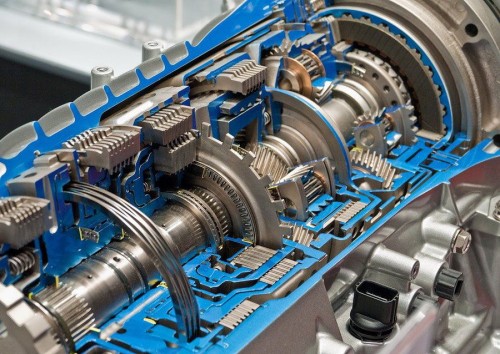
speed on automatic transmission
For vehicles that are equipped with four or five-speed gearboxes, the range selection lever (RVD), usually, has a number of forward positions - "d", "d1", "d2", "d3" (also may be indications in the form of numbers , without the letter "D" - 1, 2, 3) and one. Figures in the modes "D1", "D2", "D3" denote the top accessible transmission.
- "D1" ("L") is only the first transmission. This mode is used when the vehicle speed is not possible to develop more than 25 kilometers per hour. For greater speed, the mode is prohibited, otherwise, not avoiding strong drift. Used as an emergency option when driving in complex road conditions - forest, mountain serpentine, wetlands, soil, snow-covered, slippery roads, where you need to go slowly (as a rule, in such cases use "d2"), since this mode allows Maximum apply braking with a motor. In such a position, it is necessary to move on when the vehicle is in traffic.
- "D2" - the first two programs. RVD must be translated into such a vehicle speed less than fifty kilometers per hour. As mentioned above, "d2" is used in heavy road conditions.
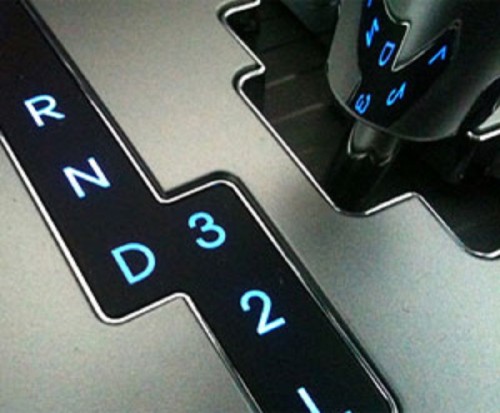
- "D3" - the first three programs. The step of reduced transmission. Braking vehicle in this mode is more efficient than in the "D" position. Therefore, it is used in situations where normal movement is impossible without frequent engineering - on dirt roads, in traffic jams, in the city or with frequently repeated descents and lines.
- "OD" - increased transmission. The level of inclusion of extreme transmission in the automatic transmission (fourth or fifth). This mode can be passed only after the development of a speed of 75 - 110 kilometers per hour and necessarily leave it if the speed is less than 70 kilometers per hour. Increased transmission makes it possible to significantly reduce fuel consumption during motor movement.
automatic Transmission Modes
As a rule, the following modes are mandatory for all vehicles with a box - "R", "R", "D" and "N". The selection of one of these modes is made using the RVD. The gear shift selection lever is actually similar in the appearance of the shift lever on the car with mechanics. The only difference is that in the automatic box, switching from one mode to another is made in a straight line.
The mode that the driver chose is displayed on the dashboard by the vehicle, which is quite convenient, since the driver does not need to be once again distracted from the road to see what position the RVD is selected at the moment.
Mode "P" (Parking) - Parking. Switching the lever to this position involves turning off the components of the vehicle control, so it should be moved to it only with a long parking lot. Also, the motor is launched from this position. It is worth noting that before turning on the "P" mode, it is necessary to fully stop the vehicle and raise the handbrake.
"R" mode (Reverse) - reverse. Used to move the vehicle by reverse. It turns on after the full stop of the vehicle when the brake pedal is squeezed.
NEUTRAL mode - neutral transmission. During the transition to this position, the motor stops transmitting the wheels to the wheels, that is, it starts to work in a frightened one. That is why it makes sense to apply neutral transmission to stops only for short time, for example, on the train crossing or traffic jams. It is not recommended to include when the vehicle is moving. Some professionals advise to switch to this transmission when towing. In this position, the RVD is allowed to start the motor.
Mode "D" (DRIVE) - movement. In this position of the gear selector, the vehicle is ordinary movement. It is worth noting that alternate gear shift, while automatically carried out while pressing the accelerator pedal.
Control automatic transmission
First of all, it must be remembered that the automatic transmissions do not like long-term slippage of wheels and sharp accelerations. The total procedure for driving the vehicle and the application of the automatic box consists of:
- The brake pedal should be dried, and the selector from the position "P", "N" or "R" to switch to the "D" position.
- Then remove the vehicle from the manual brake.
- Next, smoothly let go of the brake pedal, after which the vehicle is smooth and slowly start moving forward.
- To increase the speed, you need to use the accelerator more, which will be accompanied by an increase in gears. To reduce speed, it is enough to weaken the pressure or release the gas pedal completely. Translations will change in the direction of decline.
- If you wish a more significant slowdown or stop, you need to use the brake, and when you resume movement, it is enough to use the gas pedal.
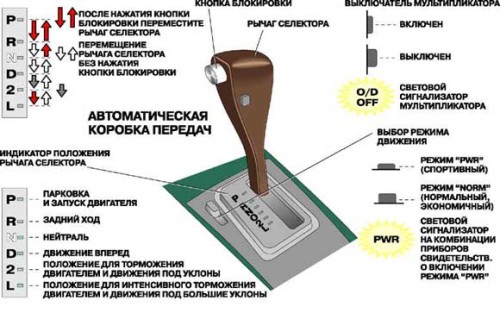
- During such a rhythm of movement, the gearbox should all the time be the position "D" (Drive), which should be changed only with a long parking lot.
Best Automatic Transmission
Undoubtedly, in comparison with the mechanics, the automatic transmission has a number of advantages:
- You do not need to track the speed position all the time - the driver can be completely concentrated on controlling the road situation and driving.
- The motor will start only in the "P" and "N" provisions, which significantly improves safety.
- More comfortable ride (braking, overclocking, start), reducing motor wear and chassis.
- In modern indirectable variasts and high-speed transmissions, in comparison with mechanical boxes, lower fuel consumption.
But the automatic transmission has several drawbacks to which one can attribute:
- Without starter, the vehicle is impossible to start.
- Overclocking dynamics are a little worse.
You can learn more useful and interesting information about automatic transmission boxes from the next video.
Related Materials
- Stove 2110, bad warm stove 2110, VAZ 2110 heating system, repairing the heating system VAZ 2110 with their own hands
- VAZ 2114 stove blows with cold air, stove 2114, bad warm stove VAZ 2114, device and repair of heating VAZ 2114 do-it-yourself, removing the stove VAZ 2114
- How to subdominize the car. How to put a jack. Types of jacks for cars.
- VAZ 2109 Fuse Block, VAZ 2109 Fuse Block Carburetor, VAZ 2109 Fuse Block Injector, Old VAZ 2109 Fuse Block, VAZ 2109 Fuse Block, VAZ Fuse Block 2109
- Car exhaust gas catalyst, faulty catalyst, pluses and cons of the catalyst, how to change the catalyst for the planeencitel
- Stove blowing cold air VAZ 2114, badly blowing the stove VAZ 2114, why badly blowing the stove VAZ 2114
- How to find out the owner of the car by the number of his car, check the car by the number of the traffic police machine, check the car by the state number of the car for free
- How to choose Used tires, Useful Tips
- Winter car road, pressure in passenger car tires in winter, good battery for the car in winter, whether to warm the car in winter
- In winter, the car is poorly started. How to make a car in winter, do you need to warm up the car in winter, useful tips
- Economy fuel consumption machines, the most economical car consumption
- Tires brands for passenger cars, labeling of car tire labeling, residual passenger car tire protector, how to pick a tire on a car brand, car tire tread pattern
- Working transmission operation, mechanical gearbox clutch work, driving with manual gearbox, useful tips
- Rear beam Peugeot 206 sedan, rear beam device Peugeot 206. Rear beam Peugeot 206 Malfunction, repair of the rear beam Peugeot 206
- Diesel fuel in winter, additive for diesel fuel in winter, how to choose the best diesel fuel
- Diesel winter does not start. How to start diesel in winter, heating diesel in winter.
- Japanese bridgestone tires, winter studded bridgestone tires, bridgestone tires brand
- Tire marking decoding for passenger cars, labeling wheels, how to choose the right tires on the disks
- Diesel engine in winter, launch of the diesel engine in winter, what oil to fill in a diesel engine in winter, useful tips
- LED backlight of the car, the backlight of the bottom of the car, the backlight of the legs in the car, the backlight in the door of the car, the backlight of the car is fine
- Recovered tires, bus tire, restored tire protector, can I use them
- Choose winter tires, which is a winter tires, which pressure in winter tires should be marked with winter tires, how to choose the right winter tires, the best winter tires 2019
- Steering rail rail, knock of steering rack, reasons for the knock and repair of the steering rack do it yourself
- Cameless car tires, a set for repair of tubeless tires, repair of the cannon-free tire do it yourself
- Russian tires, Russian tires Winter, Russian All-season tires, Voronezh AMTEL tires, Tires "Matador Omsk Tire", Kama-tires are world-class bus
- How to open a car without a key. Lost the key from the car what to do, the key from the car inside the car
- Silent tires, quiet winter tires, quiet studded bus, which tires to choose, overview tires
- Tires and safety, safety of the bus, why it is necessary to constantly monitor car tires
- Rules of safe driving of the car in the rain and slush, safe driving of the car for beginners
- Rust converter which is better for cars, rust converters to choose how to use rust transducer, professionals
- Polishing the body of the car do it yourself, how to choose a polishing paste, useful tips
- Engine durability, engine life, how to extend engine life
- Knock in the car. Knock when moving the car. What can knock in the car. How to determine the cause of the knock.
- ABS car, what is ABS car, ABS system malfunction, ABS diagnostics
- Overtaking a car when you can start overtaking a car, rules of traffic rules
- Fuel pump VAZ 2110, VAZ 2110 gas station scheme, VAZ 2110 fuel pump device, VAZ 2110 gas station repair,
- Automotive antennas for radio, automotive antenna device, car antenna do it yourself
- Front suspension Kalina, device front suspension Kalina, knock in front suspension Kalina, repair of front suspension Kalina
- Shock absorber Oil, best oil shock absorbers, pumping oil shock absorbers, how to properly pump oil shock absorber
- Clutch malfunctions, touches clutch, causes a clutch malfunction, how to eliminate
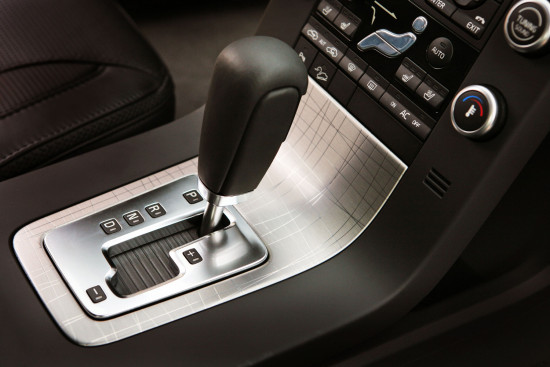
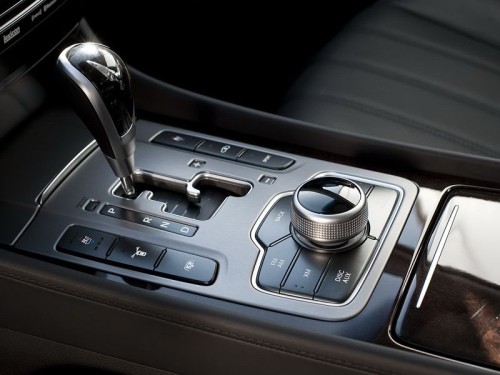
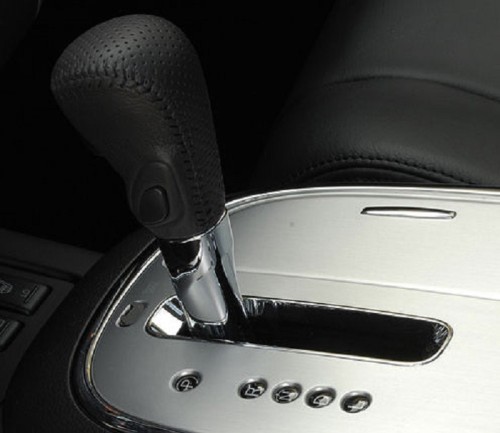








Comments